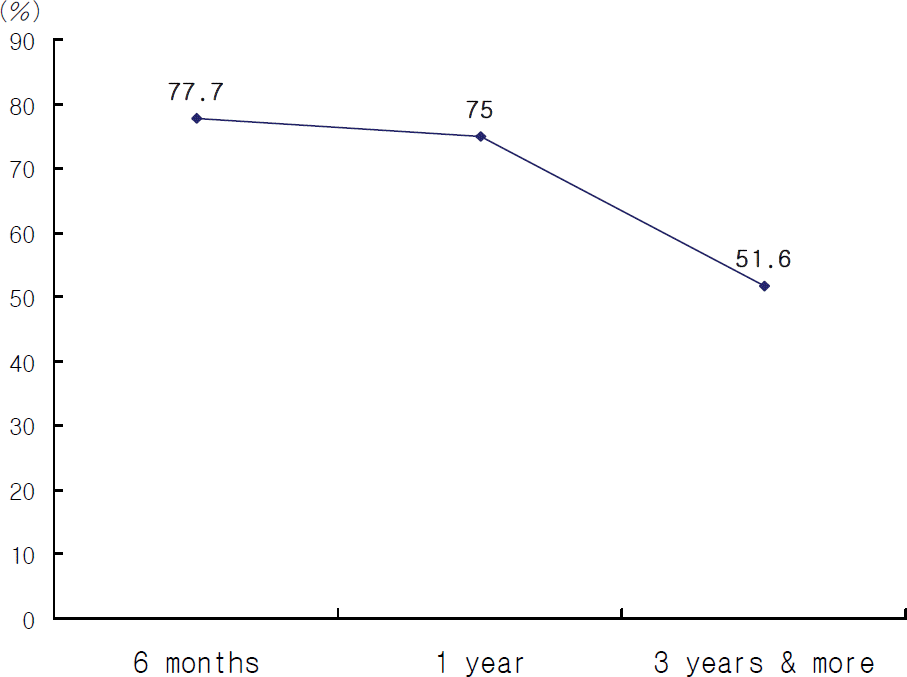Abstract
Purpose
To evaluate the results of long-term follow-up of silicone tube intubation in patients with acquired nasolacrimal duct obstruction (NLDO) that is incomplete.
Methods
A retrospective analysis was conducted of the outcomes of silicone intubation performed between 1998 and 2003. During that period, we performed silicone intubation on 109 eyes, but only 45 eyes that completed at least 6 months of follow-up were included in the analysis.
Go to : 
References
1. Beige B, O' Keefe M. Results of Crawford tube intubation in children. Acta Ophthalmol. 1993; 71:405–7.
2. Dortzbach RK, France TD, Kushner BJ, et al. Silicone intubation for obstruction of the nasolacrimal duct in children. Am J Ophthamol. 1982; 94:585–90.

3. Angrist RC, Doritzbach RK. Silicone intubation for partial and total nasolacrimal duct obstruction in adults. Ophthalmic Plast Reconstr Surg. 1985; 1:51–4.

4. Psilas K, Eftaxias V, Kastanioudakis J, Kalogeropoulos C. Silicone intubation as an alternative to dacryocystorhinostomy for nasolacrimal drainage obstruction in adults. Eur J Ophthalmol. 1993; 3:71–6.

5. Conway ST. Evaluation and management of functional nasolacrimal blockage: results of a survey of the American society of ophthalmic plastic and reconstructive surgery. Ophthamic Plast Reconstr Surg. 1994; 10:185–8.
6. Kim DM, Roh KK. Results with silicone stent in lacrimal drainage system. J Korean Ophthalmol Soc. 1987; 28:733–5.
7. Sohn HY, Hur J, Chung EH, Won IG. Clinical observation on silicone intubation in obstruction of lacrimal drainage system. J Korean Ophthalmol Soc. 1990; 1:135–40.
8. Lee SH, Kim SD, Kim JD. Silicone intubation for nasolacrimal duct obstruction in adult. J Korean Ophthalmol Soc. 1997; 8:185–9.
9. Kim HD, Jeong SK. Silicone tube intubation in acquired nasolacrimal duct obstruction. J Korean Ophthalmol Soc. 2000; 1:327–31.
10. Huh DW, Son MG, Kim YD. Silicone intubation for functional nasolacrimal duct obstruction. J Korean Ophthalmol Soc. 2000; 1:2303–07.
11. Anderson RL, Edwards JJ. Indications, complications and results with silicone stents. Ophthalmology. 1979; 6:1474–87.

12. Lauring L. Silicone intubation of the lacrimal system: pitfalls, problems and complications. Ann Ophthalmol. 1976; 8:489–98.
13. Pashby RC, Rathbun JE. Silicone tube intubation of the lacrimal drainage system. Arch Ophthalmol. 1979; 97:1318–22.

14. Katowitz JA, Holstein DA. Silicone intubation of the nasolacrimal drainage system. New York: Churchill Livingstine;1988. p. 109–23.
15. Cho KW, Lee SY, Kim SJ. Treatment of congenital nasolacrimal duct obstruction using silicone intubation set. J Korean Ophthalmol Soc. 1995; 36:553–8.
16. Bartley GB. Acquired lacrimal drainage obstruction: an etiologic classification system, case reports, and a review of the literature. Part 1. Ophthalmic Plast Reconstr Surg. 1992; 8:237–42.
17. Lee HS, Hwang WS, Byun YJ. Clinical Results of silicone Intubation for Nasolacrimal Duct Obstruction in Adult. J Korean Ophthalmol Soc. 1997; 38:1926–30.
18. Park HJ, Hwang WS. Clinical Results of Silicone Intubation for Epiphora Patients. J Korean Ophthalmol Soc. 2000; 41:2327–31.
19. Oum JS, Park JW, Choi YK, et al. Result of partial nasolacrimal duct obstruction after silicone tube intubation. J Korean Ophthalmol Soc. 2004; 45:1777–82.
20. Park JJ, Shin DS, Hong SP, Lee KW. Effects of double silicone tube intubation for nasolacrimal duct obstruction in adults. J Korean Ophthalmol Soc. 2005; 46:1951–6.
21. Lee SU, Kim EH, Lee JE, Lee JS. The clinical outcome of silicone tube intubation according to nasolacrimal duct obstruction sites by dacryoscintigraphy. J Korean Ophthalmol Soc. 2006; 47:863–70.
Go to : 
Table 1.
Characteristics of patients
| Characteristics | Mean | Range |
|---|---|---|
| Age (years) | 55.1 | 29∼82 |
| Length of follow up (months) | 30.4 | 6∼76 |
| Duration of intubation (months) | 6.5 | 1∼18 |
Table 2.
Subjective symptomatic success rate of silicone intubation




 PDF
PDF ePub
ePub Citation
Citation Print
Print



 XML Download
XML Download